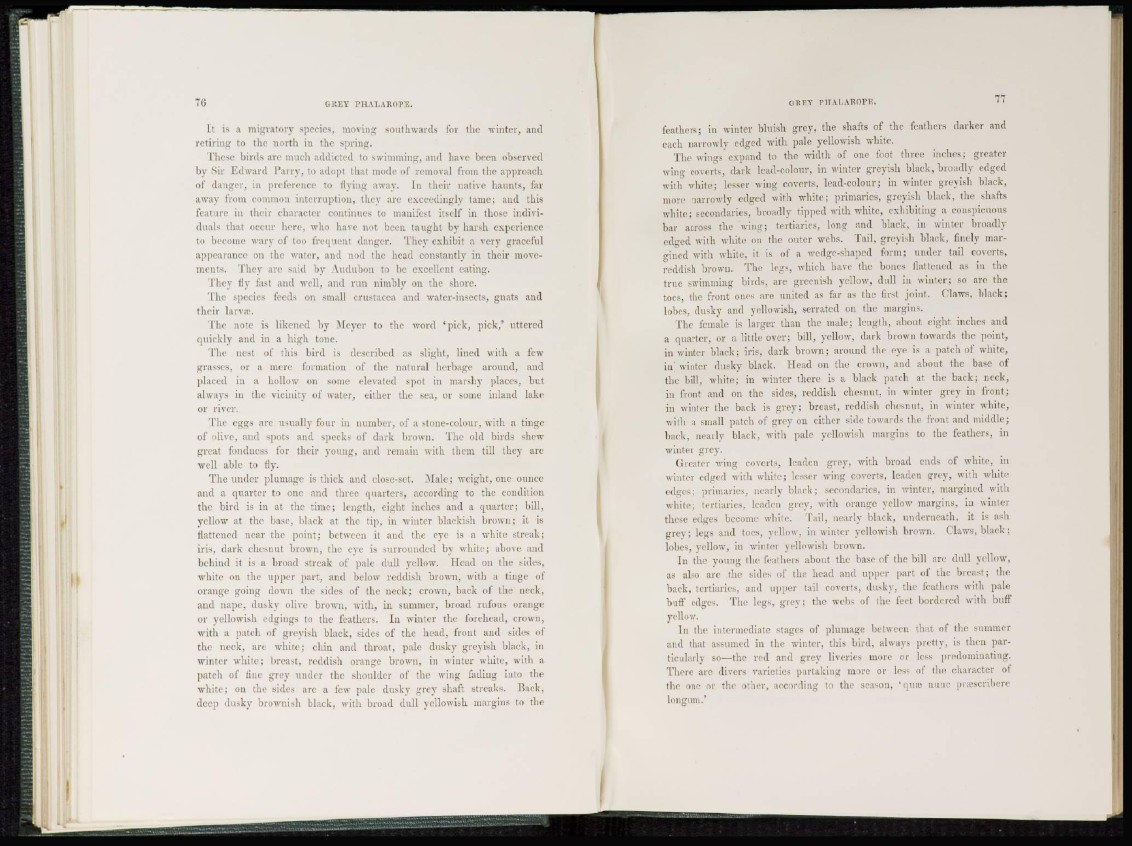
76 GREY PHALAROPE.
I t is a migratory species, moving southwards for the winter, and
retiring to the north in the spring.
These birds are much addicted to swimming, and have been observed
by Sir Edward Parry, to adopt that mode of removal from the approach
of danger, in preference to flying away. In their native haunts, far
away from common interruption, they are exceedingly tame; and this
lea'ure in their character continues to manifest itself in those individuals
that occur here, who have not been taught by harsh experience
to become wary of too frequent danger. They exhibit a very graceful
appearance on the water, and nod the head constantly in their movements.
They are said by Audubon to be excellent eating.
They fly last and well, and run nimbly on the shore.
The species feed- on small crustácea and water-insects, gnats and
their larvas.
The note is likened by Meyer to the word 'pick, pick,' uttered
quickly and in a high tone.
The nest of this bird is described as slight, lined with a few
grasses, or a mere formation of the natural herbage around, and
placed in a hollow on some elevated spot in marshy places, but
always in the vicinity of water, cither the sea, or some inland lake
or river.
Tin' eggs are usually four in number, of a stone-colour, with a tinge
of olive, and spots and specks of dark brown. The old birds shew
great fondness for their young, and remain with them till the\ are
well able to fly.
The under plumage is thick and close-set. Male; weight, one ounce
ami a quarter to one and three quarters, according to the condition
the bird is in at the time; length, eight inches and a quarter; hill,
yellow at the base, black at the tip, in winter blackish brown; it is
flattened near the point; between it and the eye is a white streak;
iris, dark chesnut brown, the eye is surrounded by white; above and
behind it is a broad streak of pale dull yellow. Head on the sides,
white on the upper part, and below reddish brown, with a tinge of
orange going down the sides of the neck; crown, back of the neck,
and nape, dusky olive brown, with, in summer, broad rufous orange
or yellowish edgings to the feathers. In winter the forehead, crown,
with a patch of greyish black, sides of the head, front and sides of
the neck, art white; chin and throat, pale dusky greyish black, in
winter while; breast, reddish orange brown, in winter white, with a
patch of fine grey tinder the shoulder of the wing fading into the
white; on the sides arc a few pale dusky grey shaft streaks. Hack,
deep dusky brownish black, with broad dull yellowish margins to the
GREY P H A l . A R O P F .. 77
feathers; in winter bluish grey, the shafts of the feathers darker and
each narrowly edged with pale yellowish white.
The wings expand to the width of one foot three inches; greater
wing coverts, dark lead-colour, in winter greyish black, broadly edged
with white; lesser wing coverts, lead-colour; in winter greyish black,
more narrowly edged with white; primaries, greyish black, the shafts
white; secondaries, broadly tipped with white, exhibiting a conspicuous
bar across the wing; tertiarics, long and black, in winter broadly
edged with white on the outer webs. Tail, greyish black, finely margined
with white, it is of a wedge-shaped form; under tail coverts,
reddish brown. The legs, which have the bones flattened as in the
true swimming birds, are greenish yellow, dull in winter; so are the
toes, the front ones are united as far as the first joint. Claws, black;
lobes, dusky ami yellowish, serrated on the margins.
The female is larger than the male; length, about eight inches and
a quarter, or a little over; bill, yellow, dark brown towards the point,
in winter black; iris, dark brown; around the eye is a patch of white,
in winter dusky black. Head on the crown, and about the base of
the bill, white; in winter there is a black patch at the back; neck,
in front and on the sides, reddish chesnut, in winter grey in front;
in winter the back is grey; breast, reddish chesnut, in winter white,
with a small patch of grey on cither side towards the front and middle;
back, nearly black, with pale yellowish margins to the feathers, in
winter grey.
( b e a t e r wing coverts, leaden grey, with broad ends of white, in
winter edged with white; lesser wing coverts, leaden grey, with white
edges; primaries, nearly black; secondaries, in winter, margined with
white; tertiarics, leaden grey, with orange yellow margins, in winter
these edges become white. Tail, nearly black, underneath, it is ash
grey; legs and toes, yellow, in winter yellowish brown. Claws, black;
lobes, yellow, in winter yellowish brown.
In the young the feathers about the base of the bill are dull yellow,
as also are the sides of the head and upper part of the breast; the
back, tertiarics, and upper tail coverts, dusky, the leathers with pale
buff edges. The legs, grey; the webs of the feet bordered with buff
yellow.
In the intermediate stages of plumage between that of the summer
and that assumed in the winter, this bird, always pretty, is then particularly
so—the red and grey liveries more or less predominating.
There are divers varieties partaking more or less of the character of
the one or the other, according to the season, *quie nunc pnescribere
longum.*